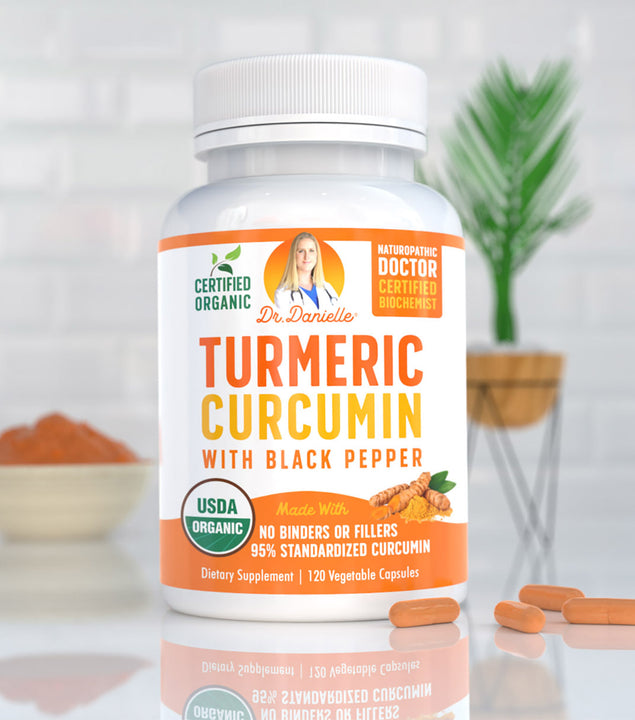Many of us take joint health for granted, believing we’ll enjoy unrestricted, pain-free movement well into our golden years. But reality paints a far grimmer picture. With age, the cartilage cushioning bones wear away—and it typically doesn’t grow back (1).
The result is sheer bone-on-bone grinding, translating into pure torture whenever you get up from a chair, climb the stairs, or attempt to play your favorite sports. Another term for all this agony? Osteoarthritis. Also known as degenerative arthritis, this painful and debilitating condition affects 32.5 million adults in the United States (2, 3, 4). Arthritic joints can become so sore and inflamed that they need to be managed with pain relievers, steroid injections, or possibly replaced entirely with mechanical substitutes, with each “solution” far from being perfect.
Steroid injections, for instance, have ironically been shown to accelerate cartilage erosion (5, 6). Chronic NSAID use increases the risk of strokes, and surgeries are prohibitively expensive for those without insurance (7). At this point, it may seem like there’s just no winning. You'll have to accept creaky, achy joints as a part of your aging process in the future … right? No. There is plenty you could do to keep osteoarthritis at bay.
In this article, I’ll introduce to you one of the best joint-health-supporting measures available: Dr. Danielle’s Joint Assist. Keep reading, and you’ll see why that’s not an exaggeration. At all.
Protect your joints and find relief with Dr. Danielle’s Joint Assist

Joint Assist blends a potent mix of glucosamine sulfate and chondroitin sulfate that work harmoniously together to add much-needed bulk to your cartilage. Further powered by hyaluronic acid to bind moisture (i.e., lubrication) to parched joints and potent antioxidants, from methylsulfonylmethane (MSM) to Boswellia serrata extract to curcumin to piperine, to fight inflammation, Joint Assist bolsters your body’s natural ability to kick osteoarthritis to the curb.
Glucosamine sulfate
Each serving of Joint Assist delivers 1,500 mg of glucosamine sulfate. Glucosamine is a natural compound—made up of glucose, and the amino acid, glutamine—your body uses to synthesize glycosaminoglycan, a type of molecule central to cartilage formation and repair (8, 9). When you're young, your body can produce adequate amounts of glucosamine to keep your joints as healthy as they can be, but, unfortunately, glucosamine production slows with age (10). That means you’ll eventually lose more cartilage than your body can repair.
So, could restoring your body’s glucosamine supply help with cartilage repair? Well, we’ll let the research speak for itself. According to this study published in Osteoarthritis Cartilage, osteoarthritis patients who took 1,500 mg of glucosamine sulfate daily for three years reported significant relief of symptoms (11).
But wait. What if you don't have osteoarthritis now and are just interested in staving off the condition? Don’t worry. Joint Assist is still your jam. In two separate studies, researchers studied the protective effects of glucosamine supplementation on knee joint health in 19 to 22-year-old soccer players and cyclists (12, 13). After three years, they found a slower rate of degradation of type II collagen—the foundation of joint cartilage—in the groups that took a high dose of glucosamine than the low-dose and placebo groups.
Methylsulfonylmethane (MSM)
First, let’s address the elephant in the room. Yes, methylsulfonylmethane (MSM) sounds scary—especially if it’s your first time encountering the term. But thankfully, it's not an unknown, toxic chemical randomly synthesized in a lab. Instead, it's an organic sulfur-containing compound naturally found in foods like fresh vegetables, meat, and dairy products (14).
So … what is 400 mg of it doing in Joint Assist? As it turns out, owing to its ability to counter inflammation (which exacerbates cartilage breakdown), MSM supplementation has been shown to relieve osteoarthritis symptoms, including joint pain (15, 16, 17).
For example, the researchers in this 2015 study published in the International Journal of Biomedical Science had 100 adults over 50 years old take either an MSM supplement or a placebo for 12 weeks (18). The results? Individuals who took the MSM supplement experienced a significant improvement in joint pain, stiffness, and swelling than those assigned the placebo medication.
Later studies, counting the likes of a 2018 meta-analysis, supported these findings (19, 20). Oh, and for those wondering why you can’t simply get MSM through your diet, here’s your answer. Food processing destroys MSM (21). And these days, nearly everything we eat is, to some extent, processed to boost shelf stability.
Chondroitin sulfate
Remember what we said about glycosaminoglycan and its importance in cartilage repair? Psst: scroll up to the section on glucosamine sulfate if you don’t. Well, chondroitin is the most abundant glycosaminoglycan in cartilage (22)!
Meaning? Supplementing with chondroitin sulfate benefits your joints in the same way as glucosamine—it ramps up your body’s cartilage repair. According to this 2018 study, chondroitin supplementation was more effective than a placebo in alleviating joint pain and improving joint function (23). Also, perhaps more impressively, a 2017 study found that a daily dose of chondroitin sulfate may provide the same pain relief as Celebrex, an NSAID (24).
Beyond their similar functionalities, there’s another reason why chondroitin (FYI: you can find 250 mg of chondroitin sulfate in every serving of Joint Assist) is commonly co-formulated with glucosamine. Lab studies show that combining these two compounds may lead to better joint health than if either were taken alone (25).
A trio of anti-inflammatory compounds
As mentioned earlier, inflammation exacerbates cartilage breakdown (26, 27). That’s why Joint Assist calls upon the potent antioxidant effects of the following ingredients—in addition to that of MSM—to promote optimal cartilage health.
200 mg of 5-Loxin® (Boswellia serrata extract)
Boswellia … what? If it makes things easier for you, you can think of Boswellia serrata as Indian frankincense. They’re the same thing. And according to a 2018 systematic review of 20 osteoarthritis-relieving supplements, Indian frankincense extract ended up among the few shown to demonstrate large and clinically meaningful effects for osteoarthritic pain reduction in the short-term (28),
100 mg of Meriva® (curcumin phytosome)
Just so you know, curcumin is the active compound in turmeric that gives the spice its flavor and color. It’s also widely heralded for its anti-inflammatory effects (29, 30, 31). Which then translates into improved joint health?
Yes, as this 2016 study shows (32). Researchers here demonstrated that the daily supplementation of curcumin helped alleviate osteoarthritis symptoms, including joint pain. More interestingly, it appears that curcumin may also work in tandem with Boswellia serrata for superior results. A 12-week study comparing a curcumin supplement with a curcumin and Boswellia combination supplement found that the latter was more effective in osteoarthritis-related pain management (33).
5 mg of BioPerine® (piperine extract)
Piperine is a beneficial plant compound found in black pepper (34). Numerous animal studies have shown that piperine could reduce osteoarthritis-related inflammation (35, 36, 37). That said, while one of the reasons Dr. Danielle decided to include piperine in Joint Assist was its anti-inflammatory properties, it wasn't the only one.
And that’s because piperine offers an arguably more valuable “attribute”: it increases your body’s absorption of curcumin by up to 2,000% (38, 39, 40)! In other words, it boosts curcumin’s beneficial effects on your joints. Is that amazing or what?
Hyaluronic acid
To finish it all off, Joint Assist offers 25 mg of hyaluronic acid per serving. And to understand why that promotes joint health, you’ll first need to know what hyaluronic acid is. Hyaluronic acid is a humectant; this means it’s a “moisture magnet” (41).
It’s a key component of synovial fluid, a thick liquid found between articulating cartilage, responsible for cushioning and lubricating the bones as they move (42, 43). Unfortunately, with age, the quality of your hyaluronic acid in the synovial fluid decreases, which often results in inflammation, pain, and swelling (44).
And at this point, you should know what comes next: cartilage breakdown. That’s where hyaluronic acid supplementation comes in. According to a 2014 study, a 3-month course of hyaluronic acid supplements eased the symptoms of knee osteoarthritis in individuals with obesity (45).
Frequently asked questions
Still have questions? Good, because we have answers.
When should I take Joint Assist?
It doesn’t matter if you take Joint Assist on a full or empty stomach. Ultimately, you should take Joint Assist whenever it’s easy and convenient for you. Find a time of day where you can easily fit the capsules into your routine (e.g., pairing it with your breakfast) because any supplement works best when you take it consistently.
How long till it works?
Well, that depends on what you hope to achieve with Joint Assist. If you're looking to boost joint health, then it's arguable that Joint Assist is effective immediately: the moment you consume the capsules.
On the other hand, if you’re looking for osteoarthritic pain relief, it may take anywhere between 12 weeks to a few years. And while that may seem awfully long, remember that it's a non-invasive and natural way of pain relief.
Is it safe for kids and pregnant or nursing women?
Joint Assist has not been tested for safety in the populations mentioned above. As with all supplements, it’s always a wise idea to first consult a healthcare professional before starting on Joint Assist.
Are your joints screaming out for Joint Assist?
Well, with everything you’ve learned about Joint Assist here, that’s only understandable. So, let’s give your joints what they want; check out Dr. Danielle’s Joint Assist right here.









2 comments
I am 4’ 11” & 110 lbs. Should I take 4 capsules or decrease the number of capsules due to my size?
I am 4’ 11” & 110 lbs. Should I take 4 capsules or decrease the number of capsules due to my size?